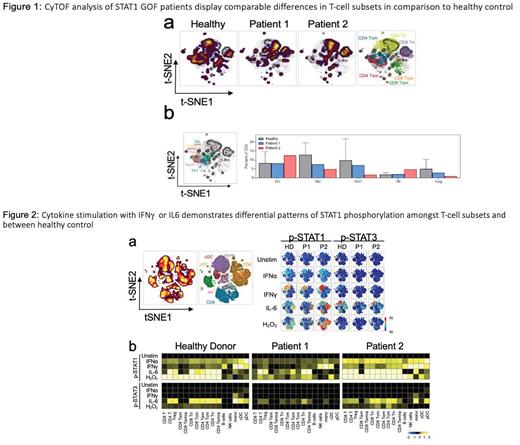Abstract
Background: Patients with heterozygous signal transducer and activator of transcription 1 (STAT1) gain-of-function (GOF) pathogenic variants exhibit an array of clinical phenotypes including susceptibility to multiple infections, autoimmunity, and cancer predisposition. Previous studies to characterize the pathways involved and explore therapeutic interventions have been constrained by the technology to perform in-depth immunophenotyping. Mass cytometry has allowed us to perform extensive immune profiling of patients with inborn errors of immunity (IEI) to help gain a better understanding of disease pathology. STAT1 gain-of-function (GOF) mutations have demonstrated higher levels of phosphorylated STAT1 in response to type I and II interferons, but the response to other cytokines is less understood. Using advanced cytometry, we demonstrate a unique pattern of STAT1 phosphorylation in response to IL-6 stimulation in T-cell subsets and this differential pattern may play a role in T-cell differentiation and memory in STAT1 GOF patients.
Cases: We report two patients with heterozygous STAT1 GOF mutations in the coiled-coil domain. For both patients, the clinical phenotype was largely consistent with other STAT1 GOF patients, one (P1, c.800C>T; p.ala267Val) presented with secondary HLH due to histoplasmosis, and the second (P2, c.866A>G; p.Tyr289Cys) presented with presumed vaccine strain varicella zoster virus (VZV) meningitis and subsequent history of recurrent herpes simplex virus (HSV) skin lesions. Patient peripheral blood mononuclear cells (PBMCs) were evaluated by fluorescence flow cytometry and cytometry by time of flight (CyTOF) as previously described (Roussel et al. J Leukoc Biol. 2017) to evaluate the impact of STAT1 GOF mutations on T-cell immunophenotype and cytokine signaling.
Results: Utilizing cytometric data, we were able to identify similar patterns of T cell distribution on t-distributed stochastic neighbor embedding (t-SNE) plots for both patients with STAT1 GOF that were distinct compared to healthy controls (Fig 1a). In the T-cell compartment, both patients had decreased Th17 and Treg populations and an increased Th1/Th2 ratio compared to healthy donor (Fig 1b). In response to stimulation with IFNg or IL-6, there were also clear patterns with the two patients compared to healthy controls. Levels of p-STAT1 and p-STAT3 were assessed in STAT1 GOF and health donor PBMCs at several times points between 15 and 120 minutes, after stimulation with either IFNg or IL-6. Using fluorescence flow, we found that IL-6 stimulation led to greater than anticipated p-STAT1 response at all timepoints compared to a much more muted response to IFNg. The cell subsets highlighted in the t-SNE after IL-6 stimulation differ from the cell subsets that respond to IFNg stimulation in patients and healthy control (Fig 2a), suggesting that distinct cell populations are driving the response to IL-6. By evaluating these IL-6 responsive subsets in comparison with healthy control by CyTOF, we identified an exaggerated p-STAT1 response to IL-6 in the memory T-cell populations in P2 (Fig 2b).
Conclusions: These two unique clinical presentations demonstrate that with similar mutations in the coiled-coil domain of STAT1, yet largely differing clinical presentations, the immune profiling patterns of the patients compared to healthy controls can drive further work on disease characterization and therapeutic interventions. This is relevant for this patient cohort, as treatment recommendations for STAT1 GOF are not well established. Long-term outcomes with JAK inhibition are lacking and transplant survival rates to date have been very poor compared to other immune diseases including familial HLH. With identification of IL-6 signaling playing a potential role in T-cell maturation, further studies will need to be performed to determine if IL-6 modulation could be used as a treatment modality. We conclude that performing deep immunophenotyping of patients with inborn errors of immunity (IEIs) such as STAT1 GOF can point to new disease mechanisms of human immunity and inflammation and lead to improved understanding of the role of cytokine and cellular signaling in normal hematopoiesis and cellular maturation.
Rathmell: Sitryx: Consultancy, Current equity holder in publicly-traded company, Research Funding; Caribou: Consultancy, Current equity holder in publicly-traded company, Current holder of stock options in a privately-held company; Nirogy: Consultancy, Current holder of stock options in a privately-held company; Merck: Speakers Bureau; Pfizer: Speakers Bureau; Mitobridge: Consultancy; Incyte: Research Funding; Calithera: Research Funding; Tempest: Research Funding.


